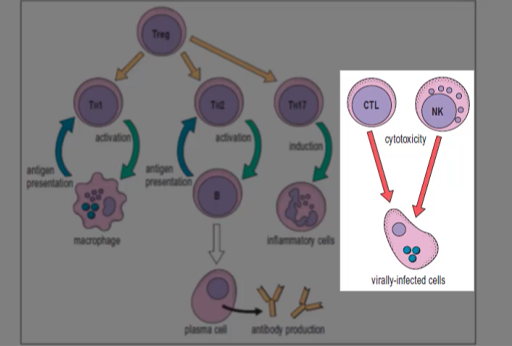1 Adaptive immune defences
In Week 1, you learnt about innate immune responses, and some of the ways that the body can recognise a virus or virus-infected cell. This week, you will learn about the adaptive immune response to viruses.
-
What is the key difference between the innate and adaptive immune responses?
-
Innate immune responses do not improve following repeated encounters with the same pathogen. Adaptive immune responses are stronger and more effective each time the same antigen contacts a person’s immune system – in essence the immune system adapts.
The principal cells of the adaptive immune system are white blood cells or leukocytes, which are distributed between various lymphoid organs such as lymph nodes and the spleen. Leukocytes traffic between organs via the blood and lymphatic system and interact with other cell types in the body in immune defence. Viruses are pathogens that live inside cells of the body but move between cells via the blood, tissue fluids and extracellular spaces. In each case, the immune system has to be able to recognise the pathogen and mount an appropriate response.
The cells responsible for immune recognition are lymphocytes, a set of leukocytes that are found in blood and throughout the body, although they are particularly concentrated in lymphoid tissues and specialised areas of mucosal tissue.
Lymphocytes fall into two basic categories: T cells, which develop in the thymus and B cells, which develop in the bone marrow.
-
What term is used for a molecule that is recognised by a lymphocyte?
-
Antigen – see Week 1, Section 2.
A third group of lymphocytes which are important in antiviral defence is the Natural Killer or NK cells. However, unlike T cells and B cells, the defence provided by NK cells does not improve significantly following repeated encounters with the same virus. For this reason, NK cells are really part of the innate immune system, although it is easier to consider them alongside T cells, since they act in complementary ways.
Video 1 below illustrates the principal cells of the immune system and explains how they are involved in immune defence against viruses.

Transcript: Video 1 Immune defence
If there is one key message you take away from this section, it is that T cells recognise antigens originating from inside the cells of the body, whereas B cells produce antibodies that recognise antigens in extracellular spaces and tissue fluids.
For the rest of this week, you will look at how lymphocytes and antibodies protect against virus infection, starting with the cytotoxic T lymphocytes.
